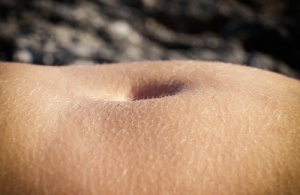Why Your Belly Button Is Full of Bacteria

Some research into our humble belly button has revealed all sorts of surprising things! There are hundreds of organisms living right inside this tiny space. In fact, our belly button is home to at least 60 species of fungi, bacteria, and yeast, according to this recent investigation.
Even though this investigation found 60 to 70 species in the average person, they found more than 1,400 in general. They vary considerably from person to person, according to Professor Rob Dunn, of the University of North Carolina.
Dunn and his colleagues have gathered bacteria from the navel skin of nearly 400 subjects. Men and women of different ages, ethnic backgrounds, and even different hygiene habits took part in the study. The investigators focused not only on bacteria contained in the samples, but the fungi and yeast as well.
Scientists have confirmed the viability of these organisms through cultures, and are now in the process of DNA sequencing for each species. The preliminary results indicate that the number of organisms per person varies greatly.
Until now, it wasn’t clear as to why people differ so much as regards bacterial communities. The differences that were discovered in this study don’t easily coincide with gender, ethnicity, age, or even frequency of bathing. In fact, this is about something else entirely.
Investigators, however, came to the conclusion that a group of relatively few bacteria species are shared among the majority of people; there are hundreds of rare species that a few people here and there possess.
According to Dunn, it’s quite possible that the majority of us share common species, but that the rare species found are inherently unpredictable.
Your belly button is your defender!
So why did the investigators decide to study the belly button? In part because they tend to harbor so many organisms that are frequently unaltered by bathing, lotions, ultraviolet light, among other things.
Dunn says that these organisms are also on our forearms, hands, and frankly, all over the surface of the body. They play an extremely important role in fighting bacteria.
They are our first line of defense against viruses found on our bodies, and are like an army living on our skin. When they find a new virus, their first instinct is to fight against it. A human being that has successfully washed the microbes off their body could be at high risk of suffering from a terrible skin infection!
The bacteria change our behavior
In one study, Professor Elizabeth Archie, from the University of Notre Dame, and her colleague Kevin Theis analyzed microbial communities in humans and similar animals. They found that bacteria can even change the behavior of those who harbor them.
As an example, steroids and other natural chemical products are found under the armpits. These compounds are the primary products of bacterial metabolism. These can give rise to all sorts of odors that affect the way we interact with others.
For instance, Corynebacterium metabolizes testosterone to produce musk, an odor similar to urine. Others metabolize tallow and sweat to produce an odor similar to onion. According to these studies, there is ample evidence demonstrating that bacteria produce strong odors. Armpit odors serve as sign of recognition sign among human beings.
These signs seem to help us distinguish individuals. Mothers, for example, have no problem recognizing their children by simply smelling their armpit. Even with these family ties, our most intimate relationships in life are those still mysterious and minuscule organisms that we barely know!
All cited sources were thoroughly reviewed by our team to ensure their quality, reliability, currency, and validity. The bibliography of this article was considered reliable and of academic or scientific accuracy.
- NCBI. (2012). A Jungle in There: Bacteria in Belly Buttons are Highly Diverse, but Predictable. https://www.ncbi.nlm.nih.gov/pmc/articles/PMC3492386/
- Science Direct. (2011). Animal behaviour meets microbial ecology. https://www.sciencedirect.com/science/article/pii/S0003347211002399
- National Geographic. (2012). What Lives in Your Belly Button? Study Finds “Rain Forest” of Species. https://news.nationalgeographic.com/news/2012/11/121114-belly-button-bacteria-science-health-dunn/
This text is provided for informational purposes only and does not replace consultation with a professional. If in doubt, consult your specialist.









